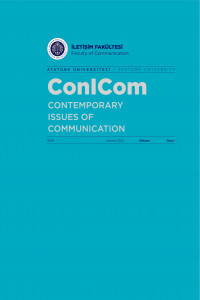Cinema Literary Adaptations as a Narrative Form
Cinema Literary Adaptations as a Narrative Form
Cinema, Literature, Adaptation Narrative Form,
___
- Bazin, A. (2011). Sinema nedir? (Trans) İbrahim Şener, İstanbul: Doruk Pub. 58
- Cartmell, D. (2012). A Companion to Literature, Film, and Adaptation. West Essex: Blackwell Publishing.
- Currie G. (1995). Image and Mind: Film, Philosophy, and Cognitive Science. Cambridge: Cambridge University Press.
- Dmytryk E. ve Dmytryk P. (2007). Sinemada Yönetmenlik, Oyunculuk, Kurgu. (Trans.) Ş. İbrahim, İstanbul: Doruk Pub.
- Ergüven, M. (2002). Yoruma doğru. İstanbul: Yapı Kredi.
- Esslin, M. (2001). Televizyon Çağı: T. V. Beyaz Camın Arkası. (Trans.) M. Çiftkaya, Ankara: Pınar Pub.
- Kale, Ö. (2010). “Edebiyat ve Sinema İlişkisi”. Uluslararası Sosyal Araştırmalar Dergisi. 3 (14). 266-275.
- Kayadevir, R. Y. (2019). “Uyarlama Sinema Filmleri Üzerine Bir Sorgulama: Sinema Seyircilerinin Okuma Pratikleri”.Sinefilozofi Dergisi. ISSN: 2547-9458. 453-473.
- Kayaoğlu, E. (2016). Edebiyat ve Film Edebiyat Bilimi Yaklaşımıyla Film Çözümlemesine Giriş. İstanbul: Hiperlink Pub.
- Kemp, P. (2014). Sinemanın Tüm Öyküsü. (Trans.) E. Yılmaz and N. Yılmaz, İstanbul: Hayalperest Pub.
- McFarlane, B. (1996). Novel to Film: An Introduction to the Theory of Adaptation. Oxford: Clarendon Press.
- Özön, N. (2008). Sinema Sanatına Giriş. İstanbul: Agora Pub.
- Ray, Robert B., (2000). “The field of ‘Literature and Film’”, Film Adaptation, Der. James Naremore, London: Athlone Press.
- Stam, R. (2005). “Introduction: The Theory and Practise of Adaptation”, Literature and Film: A Guide to the Theory and Practice of Film Adaptation, ed. Robert Stam and Alessandra Raengo, Blackwell Publishing.
- Stam, R. (2014). Sinema Teorisine Giriş. (Trans.) S. Salman and Ç. Asatekin, İstanbul: Ayrıntı Pub.
- Sokurov, A. (2008). Sinemaya giden yol mutlaka edebiyattan geçiyor. Sinema söyleşileri 2008. İstanbul: Boğaziçi University Pub.
- Yüce, T. (2005). “Sinema ve Edebiyat Türleri Arasında Görülen Etkileşimler.” Zonguldak Karaelmas Üniversitesi Sosyal Bilimler Dergisi. 1(2). 67-74.
- Başlangıç: 2022
- Yayıncı: Atatürk Üniversitesi
The Relationship Between Photography and Propaganda: The Case of Lisa Kristine
Dijital Manipülasyonun Yapay Zekâ Boyutu Deepfake Videolar: Ukrayna -Rusya Halkı Örneği
Fashion as a Concept that Designs and Consumes the Body
Photography in the Context of Installation and Dimensionality
A Review on the Social Media Postings of Clothing Brands Related to the February 2023 Earthquake
Interview with Prof. Dr. Meriç Hızal About Art
